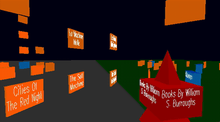GopherVR

GopherVR is an enhanced Internet Gopher client that includes a 3D visualization tool for viewing resource collections as 3D scenes. The 3D view was intended to be similar to 3D games of the time, like Spectre.[1]
In 1995,[2] the Gopher developers at the University of Minnesota released GopherVR. Using Gopher+ protocol extensions, spatial positions for Gopher resources are specified, and GopherVR clients combine traditional gopher hierarchy browsing with 3D scene navigation.[3] It was primarily written by Mark P. McCahill, Paul Lindner and Neophytos Iacovou. This original version was available for Unix, using Motif and X11, and the classic Mac OS; although incomplete, they were offered as partially functional alpha versions for testing.
Godot was another GopherVR client, it used a Z39.50 interface to libraries, allowing you to navigate the contents of a library in 3D.
The software packages for GopherVR were stored on the UMN Boombox FTP server and (probably due to a defective backup and restore) virtually all Gopher software on this server over 96k in length had become corrupted, resulting in the loss of all publicly available copies of the source code until it was rediscovered and made available by Mark McCahill in June 2008.[4]
In December 2009, GopherVR was re-released by Cameron Kaiser in an updated form for Mac OS X, Linux and other platforms.[5] It is still considered incomplete.
References
- ↑ "A Preliminary Design for a 3-D Spatial User Interface for Internet Gopher".
we can make the user experience similar to some of the better arcade style games (like Spectre)
- ↑ http://scout.wisc.edu/Projects/PastProjects/NH/95-04/95-04-21/0014.html
- ↑ https://www.myu.umn.edu/metadot/index.pl?iid=445087&isa=Category
- ↑ http://lists.complete.org/gopher@complete.org/2008/06/msg00086.html.gz
- ↑ "Archived copy". Archived from the original on 2016-09-21. Retrieved 2009-12-30.
External links
- Floodgap GopherVR project gopherspace includes source code and Mac OS X binaries
- Paper - A Preliminary Design for a 3-D Spatial User Interface for Internet Gopher
- Paper - Announcing GopherVR
- Rediscovered source code
- GopherVR in Launchpad
- Paper - Customizing Unix Servers For 3D
- TurboGopherVR Client for Mac at Sunet
- GopherVR Client for Irix at Sunet
- Godot http://www.botik.ru/~znamensk/CTAN/tools/gopher/Unix/Godot/GODOT%20v0.1